Never Miss a Sale

fabric’s Order Fulfillment Logic automates distributed order management for omnichannel retailers
Our next-generation real-time order fulfillment logic is now generally available in fabric OMS. What does that mean for retailers? According to NewStore’s 2023 Omnichannel Leadership Report, only 31% of retail websites show accurate and up-to-date information about store inventory. This places a huge strain on customer experience and brand loyalty, and there isn’t a retailer out there today who isn’t trying to improve inventory accuracy.
We decided to tackle this problem head-on, and after nearly 2 years of development and testing with our design customers using fabric OMS, we are excited to announce fabric Order Fulfillment Logic (OFL): a complete solution for order fulfillment to automate and monitor your commerce orders and update inventory visibility in real-time.
How fabric solves order fulfillment and inventory visibility challenges
fabric OFL allows you to orchestrate and optimize how your distributed order management (DOM) system works across the order fulfillment process. It helps minimize fulfillment lead times and maximize customer satisfaction with minimal effort.
Here’s how fabric OFL solves inventory visibility and delights your customers at every purchase:
- Real-time Inventory: Deliver world-class ecommerce experiences like “Shop the Store” out of the box. Plus, never miss a sale with omnichannel inventory services built on fabric’s Open APIs that provide an accurate inventory view across your entire network of stores and warehouses.
- Order Routing: Allow your teams to configure distributed order management logic with best-in-class native order routing rules without writing any code, with fabric Copilot, an easy to use UI for operators.
- Custom Alerting: Notice anomalies before they become problems with highly flexible alerting rules configured in fabric Copilot to notify operations and technology teams via email and view all orders related to alerts from an intuitive dashboard in the fabric UI.
- Omnichannel Fulfillment: Our Store Associate application for web browser and iOS-native applications gives store associates a better, more efficient experience when shipping from store. Finally, an app built with store associates in mind!
Whether you need DOM to supercharge your OMS, or you’re replacing an expensive, inflexible legacy solution with a pay-as-you-go model, our new solution can work magic.
Let’s take a closer, more technical look at how retailers can benefit from the key components of fabric OFL.
Real-time inventory
In 2024, online retailers should never have to rely solely on background jobs and schedulers. That’s why we developed a novel, NoSQL-driven approach to real-time inventory visibility, built on MongoDB and Amazon Web Services. And no, we are not managing a cache (like Redis) to serve real-time inventory. We are serving Product Detail Pages (“PDPs”) on storefronts with millions of orders and visitors per year, at high-RPS, directly from MongoDB via our platform—all with sub-50ms latency.
We’ve taken advantage of the latest modern cloud infrastructure and development architecture to make commerce inventory easy for your business operators and shoppers.
Here’s an example of how this plays out for a typical retailer. Obscuring names and numbers, this story follows Fauxyana, a fast-growing retailer selling leather bags.
Reference Inventory Architecture before and after real-time inventory with fabric OMS
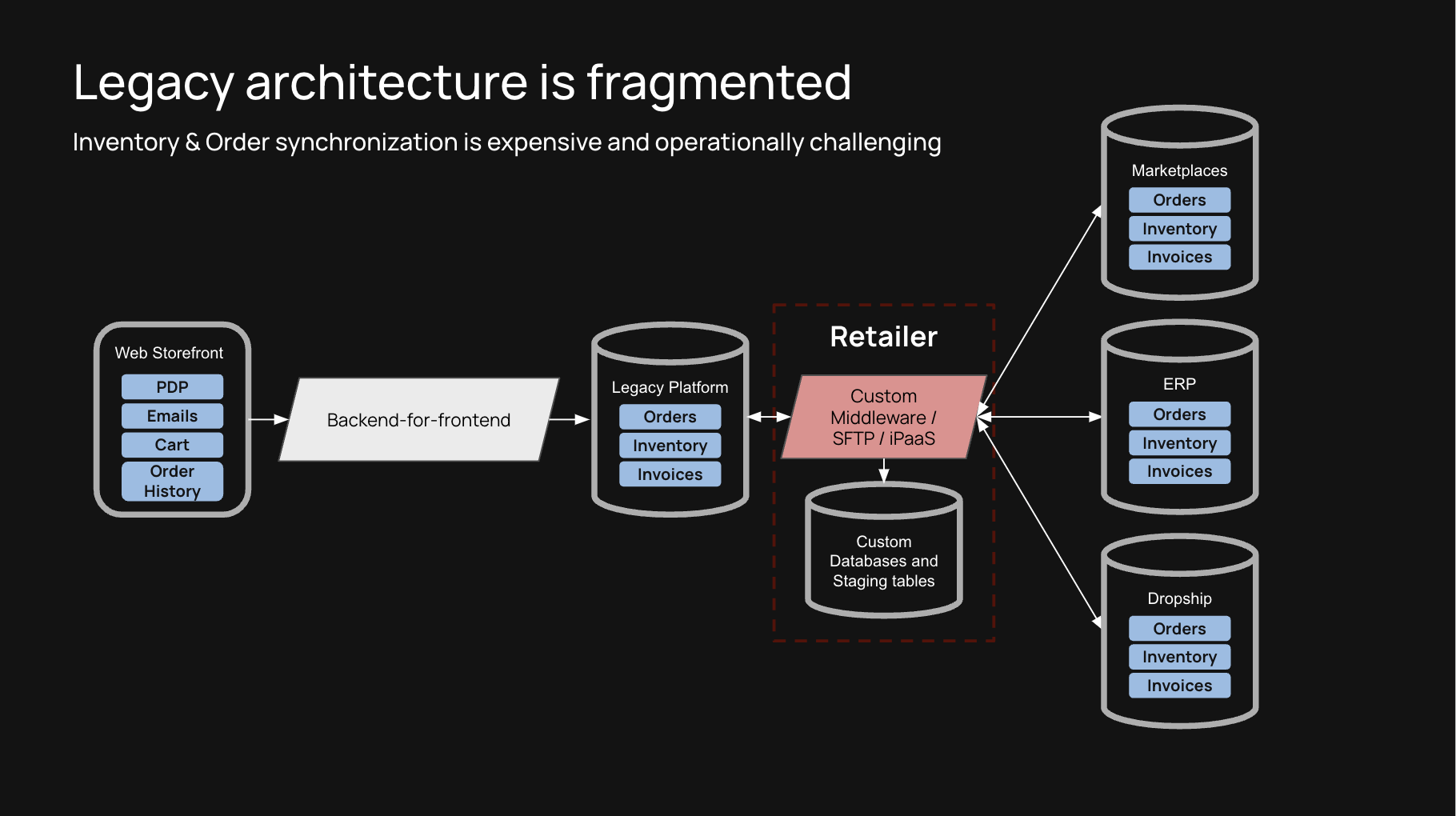
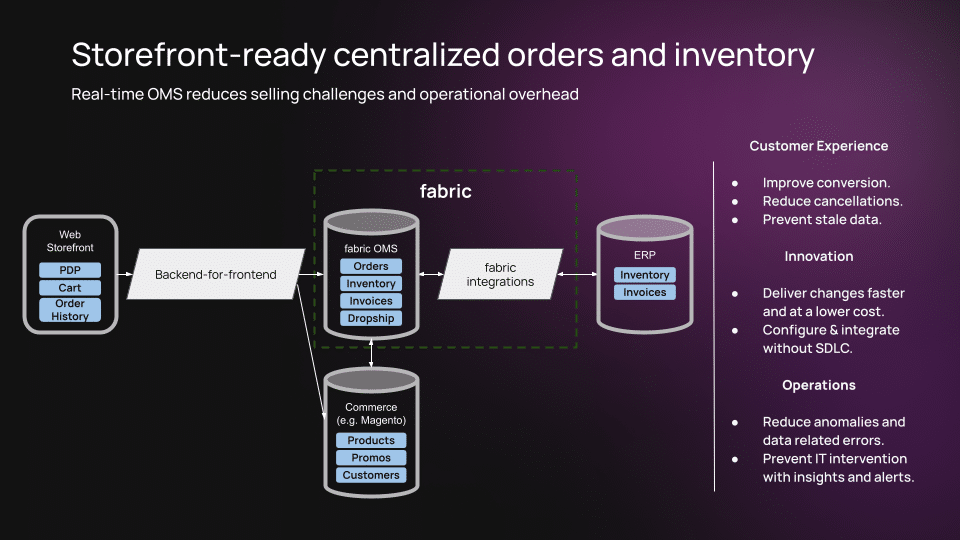
At $100M in e-commerce GMV, Fauxyana’s team knew they were losing money due to siloed and opaque inventory information. The challenge was that it had inventory databases in multiple systems: ERPs (Netsuite or SAP), 3PLs (Deliverr, FBA), and their existing commerce systems (Shopify, Magento). Inventory details were available in many places, but were not always accurate at the time of purchase, leading to canceled orders or missed sales due to out-of-stock situations online. Because of these issues, it resulted in a loss of 1% of their sales and more than 3% of their gross profit.
Fauxyana went from the snail’s pace of inventory updates every 15 minutes and slow page loads to sub-second updates for their distribution center and online storefront. With real-time inventory in fabric, it improved the customer experience by reducing overselling and out-of-stock page views on its sales channels.
Next, let’s look at how fabric OFL makes it possible to handle fulfillment optimization for even the most complex use cases.
Order Routing
A modern OMS must evaluate hundreds of possible ways to fulfill an order in milliseconds and pick the best option according to your business rules.
For example, a standard order might be evaluated first against your store fleet without split shipments, then warehouses and 3PLs without split shipments, and then a blend of stores and warehouses with up to one split shipment.
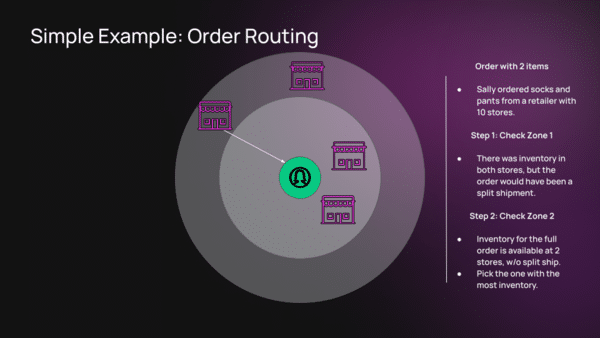
At $10M GMV, the e-commerce team at Fauxana were still able to manually handle order routing and reallocation to optimize shipping costs, split shipments, and on-time delivery across warehouses and stores. However, at $100M GMV, manual management had become unsustainable and Fauxyana needed to hire a small team of engineers to build scripts to automatically handle order routing in their ERP or integration platform.
With fabric OFL, Fauxyana is able to do a better job of routing orders using a purpose-built system for order routing automation, while redirecting time and resources to more strategic work.
An example configuration with fabric’s new Order Fulfillment Logic rule builder

Handling order routing and exceptions in custom code creates operational challenges resulting in a poor customer experience around inventory management. An OMS with an advanced order routing engine relieves the burden of managing custom code and makes it easier to ship orders on-time at the lowest cost, even in anomalous scenarios such as shrinkage.
fabric OFL automatically selects the location that has the most on-hand inventory and evaluates every possible way to fulfill the order sequentially in real-time through native rulesets.
Custom alerting
A key benefit of centralizing orders and inventory with fabric is advanced user alerts based on user-defined thresholds. fabric lets you configure your expected rates of orders and set thresholds for low, medium, and high severity anomalies around order processing so that you’re always in the know.
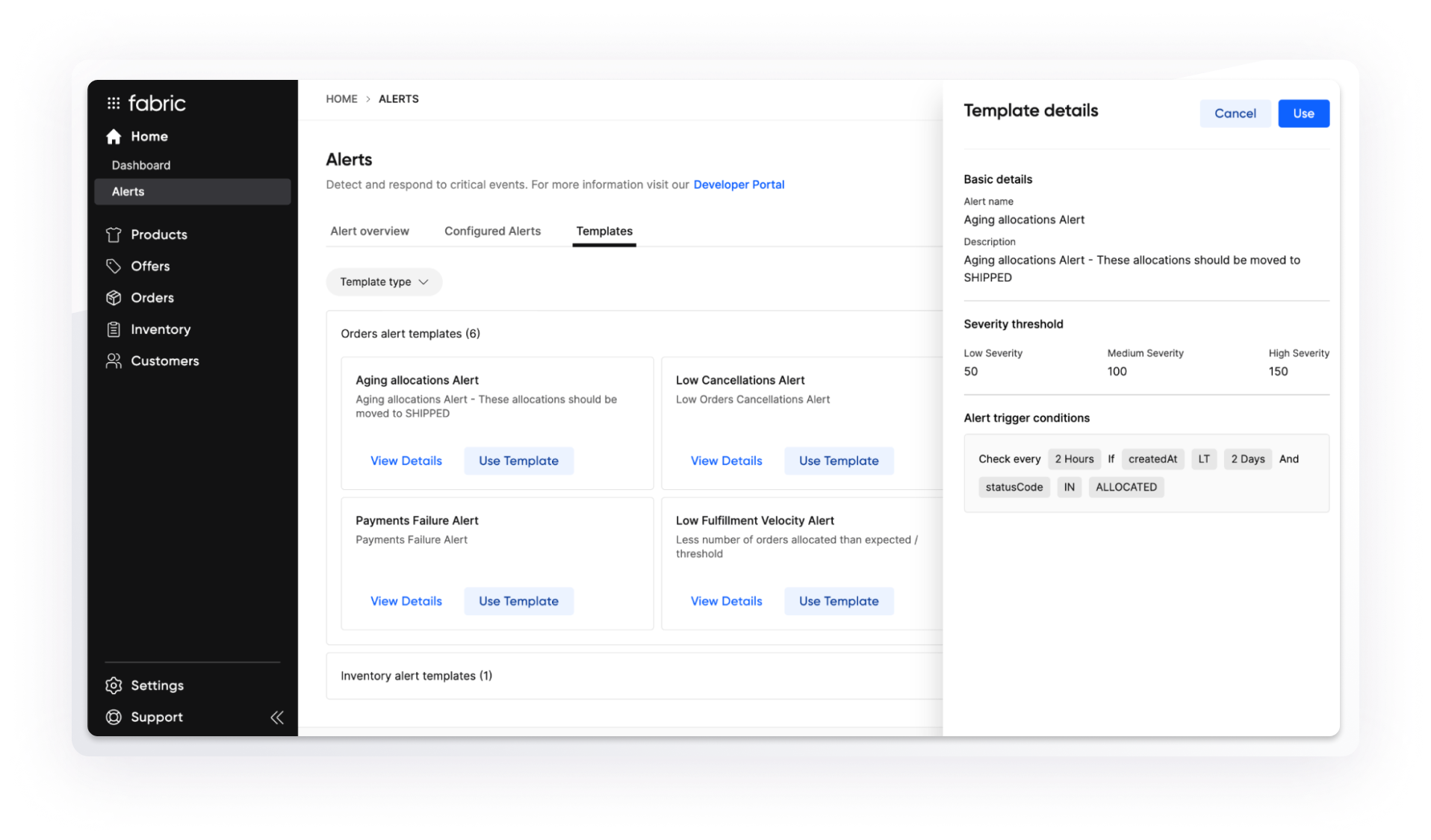
Low fulfillment velocity at your stores and warehouses, low rates of new orders, payment failures, data sync issues, and other critical insights can arrive through our new alerting system via email and fabric Copilot to ensure your teams can identify and respond to anomalies at the moment they occur.
Omnichannel fulfillment
As you scale your business to meet demand, opening physical stores is a critical way to drive customer acquisition, retention, and brand awareness. Shipping from stores is a hidden way to deliver on time, and in some cases, it can reduce your costs.
Bringing store inventory into your online sales channels can often be a key reason why retailers decide to invest in a distributed OMS.
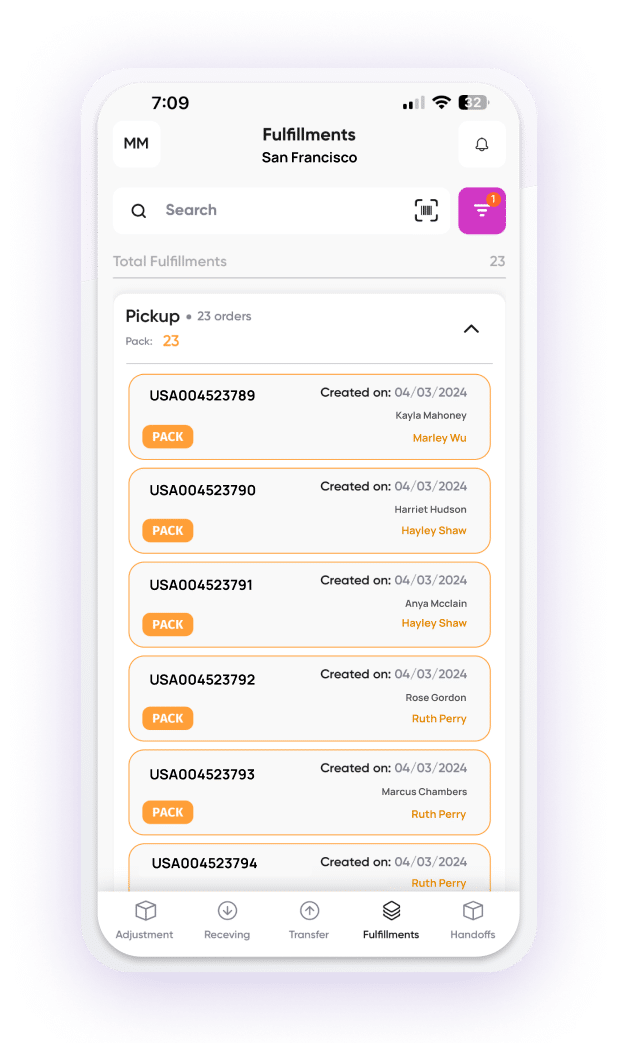
With fabric’s store fulfillment application, your store associates can pick, pack, ship, and handle pickup orders easily from either a browser or an Apple device.
Using stores to support and fulfill online sales is another way to maximize revenue from your brick-and-mortar presence. In fact, over 82% of the top 500 retail chains offer pickup in store (BOPIS) for a win-win situation, saving on costs and delighting customers with immediacy.
Always get the sale with fabric OFL
Your customers have too many retail options, all competing with you for more sales, offering more options, and promising to deliver in less time. If you’re not prepared, any hiccup in order fulfillment or the customer experience can derail a critical sale.
fabric OFL adds more intelligence to your order fulfillment processes by improving inventory accuracy, automating and monitoring order fulfillment in real-time, and enhancing the customer experience with flexibility, speed, and simplicity. It brings up-to-the-moment inventory visibility across stores, warehouses, and systems; custom alerts to keep teams aware of potential issues; and fulfillment optimizations tailored to your unique retail operation.
You know that improving order fulfillment processes and boosting the customer experience are critical to retail success in our omnichannel world. fabric OFL works for you to minimize effort and costs, reduce order lead times, and maximize customer satisfaction so you always get the sale.

Director of Product Management @ fabric. Previously Digital Product Manager @ Bed, Bath, & Beyond.